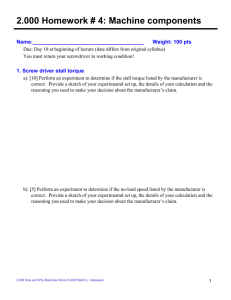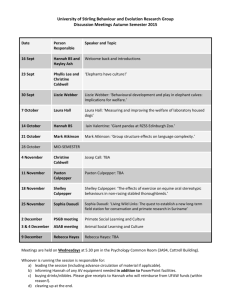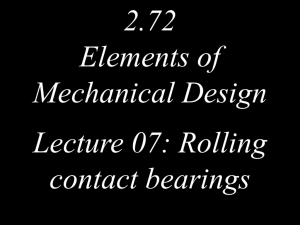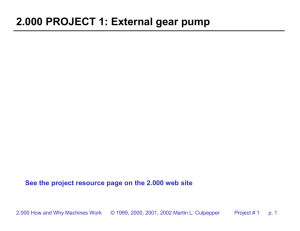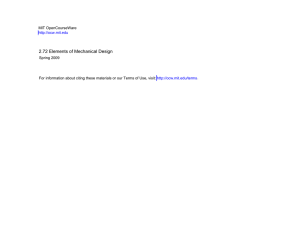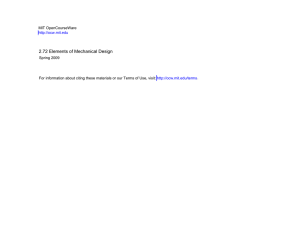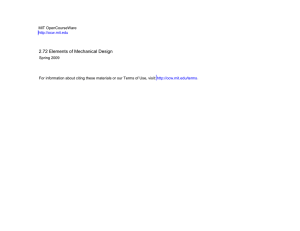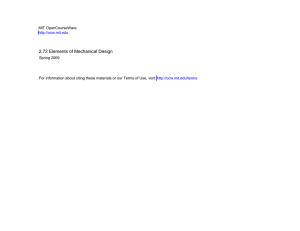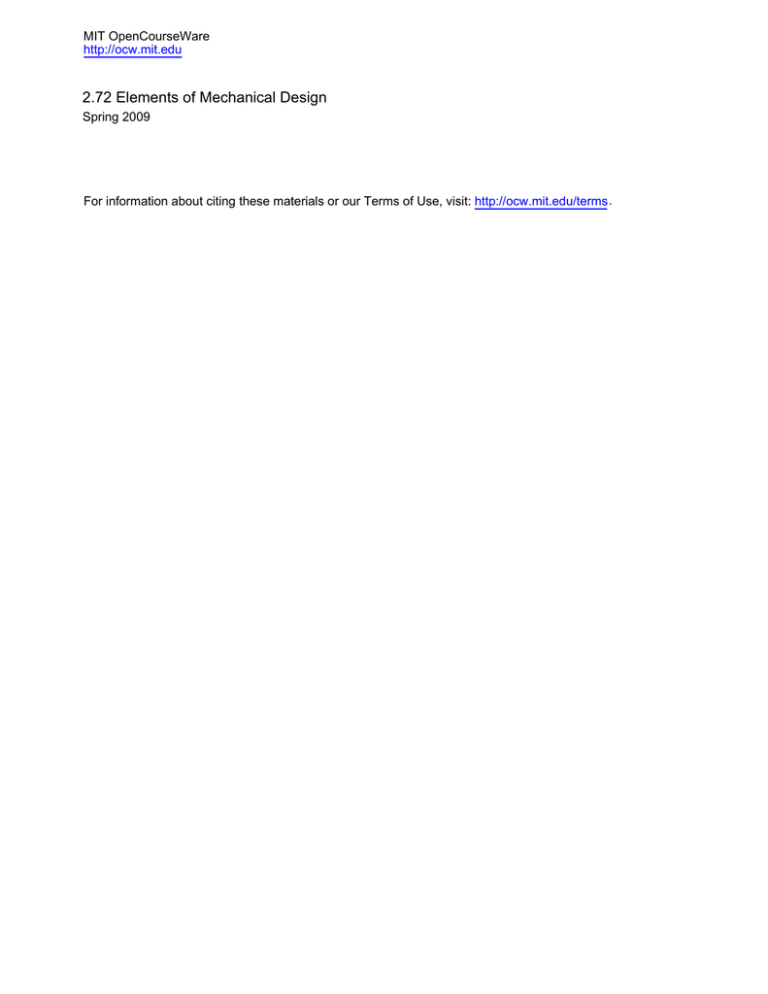
MIT OpenCourseWare
http://ocw.mit.edu
2.72 Elements of Mechanical Design
Spring 2009
For information about citing these materials or our Terms of Use, visit: http://ocw.mit.edu/terms.
Schedule
Overview
Syllabus
Project
Groups
Lab
Project
Questions
Assessment
Reading assignment for next class:
Shigley Mischke on shaft deflections & stress
• Sections 3.1, 3.2, 3.4, 3.7, 3.8, 3.10 – 3.11
Refresh on beam bending
Refresh on 1st and 2nd order system vibrations
© Martin Culpepper, All rights reserved
1
Purpose and pace of course
In-depth treatment of principles and practices required
to synthesize, model, design, fabricate & characterize.
APPLIED ENGINEERING
Teaching emphasis, style and grades reflect this
You will be expected to practice what you see in lecture
Reading ~ 50% of grade…
2/3 semester of lectures
© Martin Culpepper, All rights reserved
2
1
Info sources: Teaching staff & texts
Prof. Martin Culpepper
Required text:
Useful text:
TA: Jon Hopkins
Mechanical Engineering Design (Shigley / Mischke)
Design of Machinery (Norton)
Machinery’s Handbook
© Martin Culpepper, All rights reserved
3
Teaching philosophy
“The man who sets out to carry a cat by its tail learns something that will always be useful and which never
will grow dim or doubtful.” --Mark Twain
Thoughts, decisions & actions based on understanding:
Models and their associated equations are idealizations
Only “perfect” model is a physical embodiment
The limits/power of modeling and simulation
Mechanical system design is cost and time intensive.
Mastery of:
Concepts, principles & design processes necessary, but not sufficient
Math, physics and engineering models are necessary, but not sufficient
Practical skills and best practices are necessary, but not sufficient
The judicious use of (a), (b) and (c) is necessary
© Martin Culpepper, All rights reserved
4
2
Design project
“In theory there is no difference between theory and practice. In practice there is.” --Yogi Berra
2.72 will focus on
(i)
(ii)
understanding concepts, principles, design process, best practices,
mathematics, physics and engineering modeling; and
rigorous application of the same to realize a complex and high quality
mechanical design.
You will learn by
(i)
(ii)
Doing…
Gaining insight via interaction with staff
Project:
(i)
(ii)
(iii)
Teams of 6 work to model, design, build and characterize one lathe
You can all build copy in parallel, group must do at least one
Meeting functional requirements is critical to passing
© Martin Culpepper, All rights reserved
5
Project: Desktop lathe
© Martin Culpepper, All rights reserved
6
3
Documentation
Images and video
Take pictures/video as you go
Due in soft copy on the day their corresponding hardware/results are due
TA has camera if needed
You must keep a dedicated design notebook
Keep your ideas, calculations, and records in one organized place
Bring your notebook to all 2.72 events
Notebooks will be collected periodically, used to generate final grades
Legible and organized!
Staple or glue in loose papers, no 3-ring binders will be accepted
DO NOT take class notes in this notebook
Final report
No more than 6 pages (not including appendices)
Purpose = convince the staff that you learned & used the course material © Martin Culpepper, All rights reserved
7
Mechanical laboratories
Disassemble mechanical devices/assemblies
Take measurements, answer questions and reassemble
Tools will be provided
Bring your own safety glasses (we will give 1st pair)
Follow shop safety rules
Lab times
- Groups 1, 2 & 3 from 09.00pm – 12.00pm
- Groups 4, 5 & 6 from 02.00am – 05.00pm
Topic
1. Lathe disassembly
2. Bearing alignment
3. Transmission
4. IC Engine
© Martin Culpepper, All rights reserved
8
4
Design laboratories
45 minute meetings
15 minute presentations
30 minute discussion/design review
50 inch plasma will be available
Everyone must present their part of the project
As a group:
First tell us the purpose of the meeting
Then immediately discuss Gantt chart
Details of the work to date, calculations
Have back up slides for deep dives
9
© Martin Culpepper, All rights reserved
Parts for the lathe
Spindle
Structure
Lead screw drive
Carriage
Cross feed
Miscellaneous
Our responsibility
Your responsibility
• Housing blank
• Shaft blank
• Headstock blank
• Tail stock blank
• Structure tube blank
• Bearings
• Preload end cap
• Lead screw
• Preload washers
• Polymer bed blank*
• Handles
• Housing
• End cap
• Shaft • Bearings
• Preload mechanisms
• Rails
• Finished tail stock
• Finished tube • Finished head stock
• Preload tube
• Drive nut
• Lead screw bearing seat
• Bearing preload nut
• End skirt blanks*
*May cast 3 pieces as one, stay tuned…
• Tool holder
• Lead screw
• Drive preload nut
• Finished polymer bed* • Finished end skirts*
• Drive flexure coupling • Bushing flexure coupling
• Bushings
• Flexure bearing
• Rear flexure mount
• Front flexure mount
• Thrust bearing
• Proper dial mount surfaces/flats on screw
• Chuck
• Metrology fixtures (3-ball & runout)
• HSS cutting tool
• Fasteners ¼ - 20 bolts – 0.50 inch long ¼ - 20 bolts – 0.75 inch long ¼ - 20 bolts – 1.00 inch long © Martin Culpepper, All rights reserved
10
5
Use of ME Mfg. shop
"Good plans shape good decisions. That's why good planning helps to make elusive dreams come true." --Lester Bittel
Open M-F, 8am-4pm, Clean up at 3:30pm
Use of the machine shop must be scheduled
Lab time
Monday, Tuesday and Thursday between 8am-12pm
Wednesdays and Fridays between 1pm and 4pm
10 min. late for an appointment, your appointment will be cancelled.
Process plans
2D printed, CAD drawing with dimensions and tolerances (NO sketches)
3D printed rendering of the part (e.g. screen capture from CAD)
Properly scaled DXF (see handout) on disc/e-mail to shop manager
Completed process plan table
Shop manager must sign off and then you turn into Culpepper
11
© Martin Culpepper, All rights reserved
Grading
Grading:
50 %
50%
Project
In-class and take-home mini-quizzes
All materials are due by 5pm
Via e-mail to teaching assisstant, unless otherwise stated.
Email errors will not excuse late assignments.
You must understand otherwise you are dangerous
No student’s group may proceed w/o grade > 80% on qualifiers
Make up quizzes may be given, but course schedules won’t change
Quizzes
Take-home quizzes
© Martin Culpepper, All rights reserved
Reading quizzes
In-class exercises
12
6
Rules for collaboration
You should work together & learn from one another
What you submit MUST be your own work unless it is specified as
a group submission. In the case of group submissions, everyone
that worked on the submission must sign a cover page and
provide bullet point summaries of what you worked on and how
much of that part you did
You MUST acknowledge the contribution of others
For example, after working an assignment independently, you compare
responses with another student which alerts you to an error in your own
work which you then correct. You should state at the end of your
submission that you corrected your error on the basis of checking
responses with the other student. No credit will be lost if the response is
correct, the acknowledgment is made, and no direct copying of the other
response is involved.
© Martin Culpepper, All rights reserved
13
Course Web Site
http://pcsl.mit.edu/2_72/index.html
Reading assignments
Quiz materials
Lecture notes
Software downloads
Homework downloads
© Martin Culpepper, All rights reserved
14
7
Form groups & assign gurus
Group 1
Group 4
Group 2
Group 5
Group 3
Group 6
© Martin Culpepper, All rights reserved
15
Assessments
Assessment A
On web
15 minutes
Assessment B
In class
45 minutes
Can’t hurt you, only help – extra credit
© Martin Culpepper, All rights reserved
16
8

